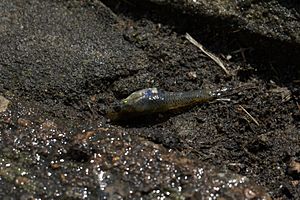Mosquitofish in Australia facts for kids

The eastern mosquitofish (Gambusia holbrooki) is a small fish that was brought to Australia in 1925. It was meant to help control mosquito numbers. However, it has spread widely across Australia and is now considered a harmful pest. It is against the law to release these fish into the wild or move them between states.
Even though they were introduced to eat mosquitoes, studies show they don't do a good job. Mosquitofish mainly eat tiny water creatures like zooplankton, beetles, and other insects. Mosquito larvae are only a small part of their diet. In fact, if they only eat mosquito larvae, they don't grow well and can even die.
Contents
Why Mosquitofish Don't Control Mosquitoes
Many fish experts, called ichthyologists, believe that Australia's native fish are much better at controlling mosquito populations. Examples include the western minnow and pygmy perch.
Sadly, mosquitofish might have made the mosquito problem worse in some areas. They are very aggressive and have many babies. This means they can outcompete native animals that would normally eat mosquito larvae. Because of this, mosquitofish can take over an area and harm local fish populations.
Studies have also shown that you would need huge numbers of mosquitofish (at least 5,000 fish per hectare) to control mosquitoes effectively. Mosquito breeding spots also change often, so fish predators don't always help much year to year.
Mosquitofish Biology and Survival
Mosquitofish are very tough fish. They can live in many different types of water. They can handle salty water, water with low oxygen, and extreme temperatures (from almost freezing to very hot). They can also survive in water with many pollutants. This includes things like heavy metals and insecticides.
Their ability to adapt has allowed them to spread widely. Fish experts think that if there are fewer mosquitoes in areas with mosquitofish, it's often because of insecticides in the water, not because the fish are eating them.
How Mosquitofish Harm Native Wildlife
Mosquitofish have caused a lot of damage to Australia's native animals. They are linked to the decline of at least 9 native fish species and 10 native frog species.
Impact on Water Quality and Other Animals
Mosquitofish eat zooplankton, which are tiny animals that usually eat algae. When mosquitofish eat too much zooplankton, it can lead to more algae growing in the water. This makes the water quality worse.
These fish are also very aggressive. They often attack other fish and nip at their fins. This can cause infections or even death for the native fish. For example, the purple spotted gudgeon fish has seen its numbers drop because of many mosquitofish.
They also harm populations of other water creatures. This includes beetles, backswimmers, rotifers, red finned blue eye, Edgbast goby, crustaceans, and mollusks. In Tasmania, mosquitofish are known to attack and kill adult dwarf inanga fish. If mosquitofish take over an area, they can put a lot of stress on the remaining plants and animals.
Threat to Native Frogs
Mosquitofish are a big threat to native frog populations. They eat the tadpoles of many frog species. For example, they eat the tadpoles of the Limnodynastes ornatus frog. Researchers believe that over time, mosquitofish could wipe out entire frog populations.
They also eat tadpoles of other related frogs, like the green and golden bellfrog. This frog in Tasmania is now directly threatened by mosquitofish. Studies show that tadpoles are safer in places without these introduced fish. The green and golden bellfrog tadpoles don't seem to recognize mosquitofish as a danger. This means they don't try to hide from them.
Protecting Endangered Species
The Edgbaston hardyhead is a rare fish that lives in only one spring-fed pool in central Queensland. This hardyhead fish competes with the mosquitofish for food. If the mosquitofish wins this competition, it could cause an entire species to disappear. Because of this, protecting the hardyhead is a top priority in Queensland. Steps are being taken to remove mosquitofish from this special spring.
Controlling Mosquitofish Populations
In 1999, the mosquitofish was named an environmental hazard in New South Wales. This made it illegal for people to do anything that helps mosquitofish spread. This includes releasing pet mosquitofish into rivers, which is a big problem in eastern Australia.
Scientists have thought about ways to control mosquitofish. Some ideas include introducing diseases or parasites that only affect mosquitofish. However, many diseases can spread to native fish, which would be harmful.
The government in Tasmania is working to stop mosquitofish from spreading. They are trying to keep them in their current locations. At Gordon’s Lagoon in the Clarkesdale Bird Sanctuary in Linton, Victoria, park managers have drained ponds during dry times. They then treat the wet areas with lime. This changes the water's pH and kills the fish.
Mosquitofish also do well because they eat decaying matter and general waste.
Images for kids


